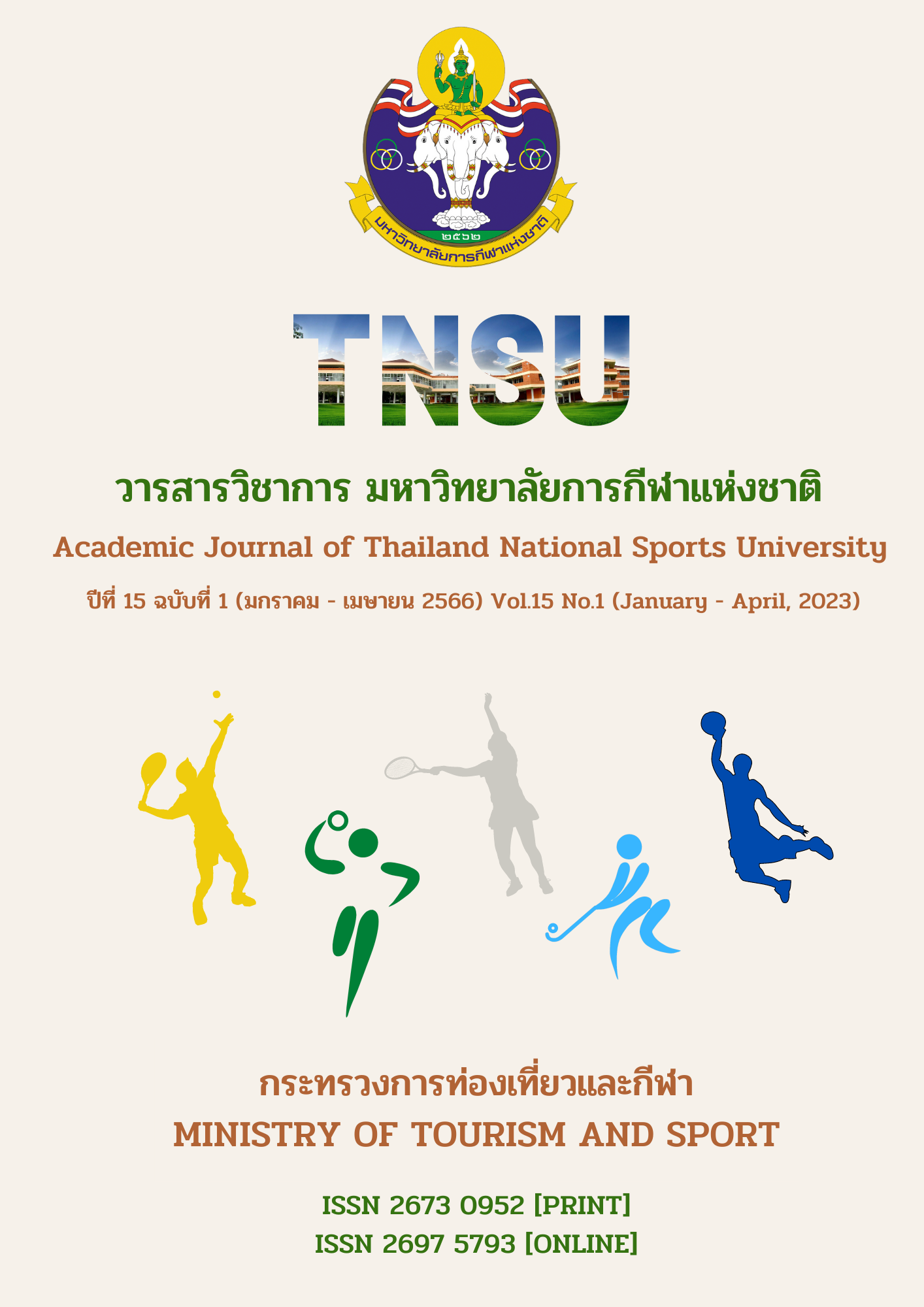EFFECT OF HIGH INTENSITY INTERVAL CIRCUIT TRAINING PROGRAM ON OVERWEIGHT STUDENTS’ BODY COMPOSITION
Main Article Content
Abstract
The purposes of this research were to investigate and compare the effect of high intensity interval circuit training program on overweight students’ body composition. The research instrument was the constructed high intensity interval circuit training program, the IOC of which was 0.90. The research samples were thirty Matthayom 3 overweight students aged between 14 - 15 years old from Banharn Jamsai Wittaya 3 School by purposive sampling. They were divided into two groups, each of which comprised fifteen overweight students. The control group was given to conduct their lives normally and the experimental group was trained with the constructed training program sixty minutes a day, three days a week for eight weeks. The Body Mass Index (BMI) and the Percent Body Fat (PBF) were tested before training, after the fourth and the eighth training weeks. The data were analyzed by mean, standard deviation, t - test dependent, one - way analysis of variance in repeated measure, and pairwise comparison by Least Significant Difference (LSD) method at the level of 0.05.
The findings revealed that no significant differences in BMI between the control and the experimental groups were found before training while significant differences in BMI between both groups were found after the fourth and the eighth training weeks at the level of 0.05. No significant differences in PBF between both groups were found before training, after the fourth and the eighth training weeks. Significant differences in BMI and PBF within both groups were found before training, after the fourth and the eighth training weeks at the level of 0.05. In conclusion, training with the constructed high intensity interval circuit training program for over four weeks can help reduce the BMI and the PMF of overweight students.
Article Details

This work is licensed under a Creative Commons Attribution-NonCommercial-NoDerivatives 4.0 International License.
The published article is a copyright of the Academic Journal of Thailand National Sports University. The passage appeared in each article in this academic journal is a perspective of each author which is not related to the journal. Each author is required to be responsible for all components of his/her own article. If there are any mistakes, each author must be responsible for those mistakes on his/her own.
References
BBC Thai. (2018). UN warns of obesity crisis among children in Asia - Pacific Thailand ranks high in ASEAN. Retrieved from https://www.bbc.com/thai/thailand-43695753
Charoen Krabuanrat. (2014). Science of Coaching. Bangkok: Sin Tana Copy Center.
Edward W. G., & Jonathan E. S. (2017). Global health effects of overweight and obesity. The New England Journal of Medicine, 377(1), 80 – 81.
Hu, J., Liu, M., Yang, R., Wang, L., Liang, L., Yang, Y., … & Cai, M. (2022). Effects of high-intensity interval training on improving arterial stiffness in Chinese female university students with normal weight obese: A pilot randomized controlled trial. Journal of Translational Medicine, 20(60), 1 – 14.
James Driver. (2017). HIIT - high intensity interval training explained. England: Create Space Independent Publishing Platform.
Kanlayanee No-in. (2017). Overweight and obesity among Thai school - aged children and adolescents. Journal of the Royal Thai Army Nurses, 18(2), 1 – 8.
Martin - Smith, R., Cox, A., Buchan, D. S., Baker, J. S., Grace, F., & Sculthorpe, N. (2020). High intensity interval training (HIIT) improves cardiorespiratory fitness (CRF) in healthy, overweight and obese adolescents: A systematic review and meta - analysis of controlled studies. International Journal of Environmental Research and Public Health, 17(8).
Medical News Today. (2020). What are the benefits of high intensity interval training. Retrieved from https://www.medicalnewstoday.com/articles/327474
Grand Canyon University. (2020). Benefits of high intensity interval training. Retrieved from https://news.gcu.edu/2020/04/benefits-of-high-intensity-interval-training-hiit/
Piyapong Saysawat. (2015). Effects of progressive interval training program on body mass index, body composition and maximum oxygen consumption of overweight / obese female college students (Master’s thesis), Burapha University.
Rumpai Munsraket. (2020). Health promotion of school - age children with obesity to reduce risks of diabetes in school. Regional Health Promotion Center 9 Journal, 14(35).
Tavorn Kamutsri. (2017). Physical fitness conditioning. College of Sports Science and Technology, Mahidol University.
Ukris Utensute. (2016). A study of diet control and exercise in overweight patients in Wetchakarunrasm Hospital. Journal of Hospital Charoenkrungpracharak (JCP), 12(2), 71.
Waranya Thongbai. (2020). Effects of hight intensity interval training on health - related physical fitness in overweight secondary students (Master’s thesis), Naresuan University.
Weeraphan Phrompinij, Ratree Ruangthai, & Niromlee Makaje, (2019). Effect of high intensity interval training in deep water and treadmill on maximal oxygen consumption in team athlete. Journal of Sports Science and Technology, 19(2), 1 - 19.
Wichai Aekplakorn. (2018). Thai people's health survey 2014: Child health (5thed.). Health Systems Research Institute.


